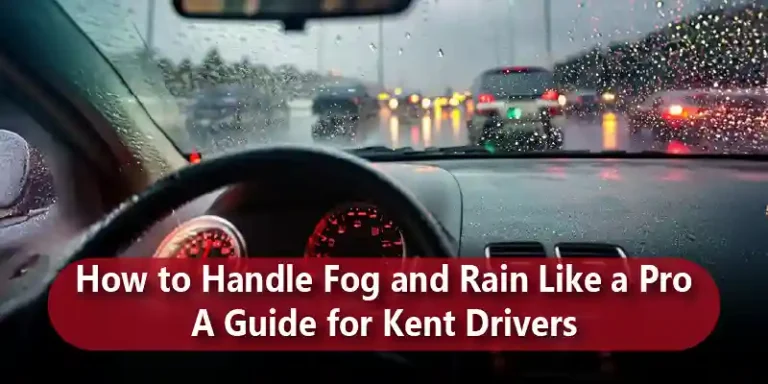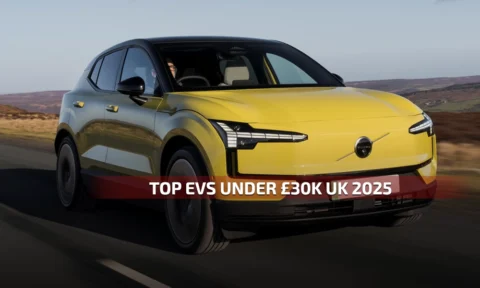The beautiful, winding roads of Kent, from the coastal stretches to the M20 corridor, can quickly turn treacherous when the weather closes in. Local drivers know that a bright morning can swiftly dissolve into a thick, pea-souper fog, or be replaced by torrential downpours characteristic of the rainy weather driving tips UK landscape demands.
This comprehensive guide is designed to equip you with the expert knowledge and practical strategies needed to master those challenging conditions, ensuring you get home safely, even when visibility drops to zero. We’ll dive deep into techniques, essential preparations, and the mindset of a defensive driving in bad weather.
Decoding the Danger — Why Fog and Rain are Kent’s Biggest Hazards
For drivers across the UK, especially in a county like Kent with diverse road types, adverse weather presents two primary threats: reduced visibility and compromised road grip.
Kent’s low-lying areas, especially near the marshes and river valleys, are notorious for the sudden onset of thick fog. This is more than just a nuisance; it’s a critical safety hazard. Driving in fog Kent requires a complete shift in technique.
The key danger is the optical illusion fog creates. It makes it extremely difficult to judge distance and speed, leading to tailgating and panic braking. The most critical lesson in how to drive safely in fog UK is this: you must slow down significantly and manage your lighting correctly.
The Challenge of Heavy Rain
Safe driving in rain Kent is often a matter of managing water, not just speed. Water on the road leads to two major issues:
- Reduced Traction: The film of water dramatically cuts the friction between your tyres and the road surface, increasing stopping distances.
- Hydroplaning (Aquaplaning): When your tyres lose contact with the road altogether, essentially ‘floating’ on the water. This results in a total loss of steering control and is terrifyingly common in heavy downpours.
Mastering the Fog: Essential Fog Safety Tips for Drivers
When you encounter fog, your immediate actions are crucial. Adopting a proactive stance is the cornerstone of effective fog safety tips for drivers.
1. Decelerate Immediately and Smoothly
The first, non-negotiable step when driving in fog Kent is to slow down. The speed limit is a maximum for ideal conditions, not an obligation.
Ease off the accelerator gradually. Defensive driving in bad weather prioritises smoothness. Sudden braking can be disastrous, as the driver behind you is also struggling with visibility.
Leave more space between your car and the one in front.. In heavy fog, your normal two-second gap should increase to a minimum of ten seconds.
2. Lights, Not High Beams
Understanding your lights is paramount for how to drive safely in fog UK.
- Front Fog Lights: Use your front fog lights when visibility drops below 100 metres. These lights are mounted low on the car and are designed to cut through the fog without reflecting into your eyes.
- Rear Fog Lights: Switch on your rear fog lights as soon as visibility is severely reduced. They are vigilant drivers behind you.
- Crucial Mistake to Avoid: Never use high beam headlights in fog. The powerful light reflects off the fog droplets, creating a blinding wall of white light that severely reduces your own vision.
3. See and Be Seen (Visibility Tips for Drivers)
Beyond your lights, your car’s windows must be spotless.
- Clear Glass: Use your demister and air conditioning (AC) to dry the air inside the car, preventing the windscreen from fogging up internally. A clean exterior windscreen is vital for maximum visibility tips for drivers.
- Use the Edge: If visibility is truly zero, use the white lines at the side of the road or the centre line as your primary guide. This technique keeps you from drifting into other lanes or off the road.
Taming the Rain — Proactive Wet Weather Driving Techniques
Rainy conditions in Kent demand a deliberate and controlled driving style. Rainy weather driving tips UK are centred on managing speed and steering input.
1. Reduced Speed and Increased Following Distance
This is the golden rule for safe driving in rain Kent. Wet roads dramatically increase your stopping distance.
- Speed Management: Reduce your speed by at least 20% on wet roads. A lower speed is the best defence against hydroplaning.
- The Four-Second Gap: Double your standard following distance from two seconds to four seconds. This buys you crucial time to react if the car in front brakes suddenly.
2. Avoiding Hydroplaning
Hydroplaning is the moment of truth for drivers in heavy rain. It typically occurs above 45-50 mph.
- Grip Check: If you feel the steering lighten or hear a sudden change in the sound of water splashing you may be hydroplaning.
- The Remedy: Do not brake hard or turn the steering wheel sharply. This is a crucial defensive driving in bad weather. Instead, ease your foot off the accelerator gently and keep the steering wheel pointed straight until you feel the tyres regain traction.
3. Dealing with Surface Water
Watch out for standing water, especially on unmaintained roads or beneath bridges in Kent.
- Puddles and Spray: Slow down significantly before hitting a large puddle. The bow wave created by passing a car can momentarily blind other drivers (known as “spray”). Slowing down is not only for your safety but also a courtesy to other road users.
- Braking After Water: After driving through a deep puddle, tap your brakes lightly a few times to dry the brake pads and discs. This is a key piece of car maintenance for wet weather and ensures your brakes are immediately responsive.
Preparation is Key — Winter Driving Tips Kent and Maintenance
Driving like a pro starts before you even turn the ignition. Proactive maintenance is a fundamental aspect of road safety tips for Kent drivers and is vital for wet and cold conditions.
1. Tyres: The Only Contact with the Road
Your tyres are your single most important safety feature.
- Tread Depth: For safe wet-weather driving, experts recommend replacing tyres when the tread drops below 3mm. Worn tyres cannot effectively displace water, dramatically increasing the risk of hydroplaning.
- Pressure: Check your tyre pressure weekly. Incorrect pressure compromises grip, steering, and braking.
2. Visibility System Maintenance
An effective visibility system is non-negotiable for visibility tips for drivers.
- Wiper Blades: Blades should be replaced every 6-12 months. Wipers that leave streaks are inadequate for safe driving in rain Kent.
- Screenwash: Keep your screenwash topped up with a high-quality additive that prevents freezing in the colder months, essential winter driving tips Kent preparation.
- Clean Lights: Ensure all headlights, tail lights, and fog lights are clean. Visibility is a two-way street: you need to see, and others need to see you.
3. Battery and Engine Checks
Cold, wet weather puts extra strain on your car’s electrical system (wipers, lights, demisters).
- Battery Health: Have your battery tested. A battery struggling to cope with cold weather is a common cause.
- Fluid Levels: Check oil, coolant, and brake fluid. This general car maintenance for wet weather ensures your vehicle is performing optimally when you need it most.
The Pro Mindset — Defensive Driving in Bad Weather
A professional driver doesn’t just react to hazards; they anticipate them. Adopting a defensive driving in bad weather mindset is the ultimate protection on Kent’s roads.
1. Look Further Ahead
Scanning the road ahead gives you more time to react.
- Look past the car in front to spot hazards like flashing brake lights, heavy spray, or patches of dense fog further down the road. This allows you to reduce before going smoothly.
2. Avoid Cruise Control
When the roads are wet, or visibility is poor, keep your feet in control.
- Why Avoid It: Cruise control can hinder your ability to react instantly. If you hydroplane, the car may attempt to accelerate, exacerbating the problem. Keeping full manual control is a basic road safety tip for Kent drivers in adverse conditions.
3. The Pull-Over Option
A professional knows their limits and the car’s limits. If the weather is genuinely too severe, the bravest thing you can do is pull over.
- Safety Stop: If the fog or rain is so heavy that you cannot see the edge of the road, find a safe lay-by or parking area, pull completely off the road, turn off your lights (so they don’t confuse other drivers), and wait it out. A five-minute delay is infinitely better than a collision. This is the final, most crucial element of fog safety tips for drivers.
Driving Smarter, Not Harder
Navigating Kent’s roads in challenging conditions requires a blend of preparation, maintenance, and expert driving technique. By mastering your lights for driving in fog Kent, respecting stopping distances in the rain, and ensuring your car maintenance for wet weather is up to date, you move beyond being just a driver you have to become a proficient road master. Embrace these winter driving tips Kent and commit to a philosophy of defensive driving in bad weather, and you will handle every commute like a true professional.
Most Common Questions
You should turn on your fog lights when visibility drops below 100 metres. Remember to switch them off when visibility improves, as they can dazzle other drivers.
Use your car’s air conditioning (AC) system, even in winter. The AC unit dehumidifies the air, rapidly clearing internal condensation, which is a key part of visibility tips for drivers.
No. The speed limit is the maximum speed in ideal conditions. All road safety tips for Kent drivers stress that in bad weather, you must reduce your speed significantly to match the reduced visibility and increased stopping distance.
The standard 2-second rule should be extended to at least 10 seconds in heavy fog. This extreme distance is essential for safe driving in fog Kent due to the difficulty in judging distance.
Your tyres are the most critical element. Ensure their pressure is correct and their tread depth is well above the legal minimum for effective water displacement, which is a major point in car maintenance for wet weather.
Join the conversation at Ask about cars—your daily source for automotive wisdom.







